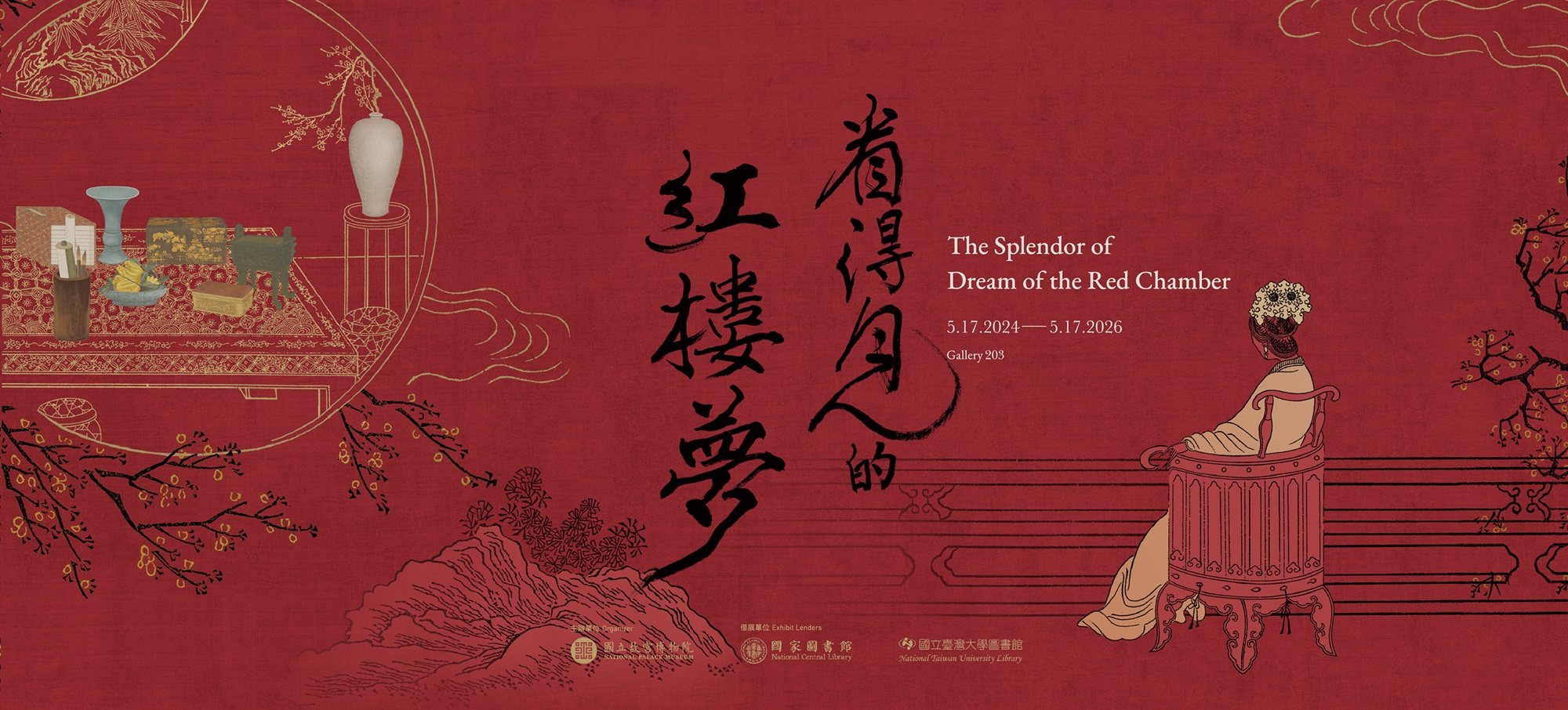The Stately Elegance
Dream of the Red Chamber, also known as The Story of the Stone, begins with the tale of a stone forsaken by goddess Nuwa after she patched up the collapsed heaven. The stone eventually reincarnated into the human form as the protagonist, Jia Baoyu, who was born with a piece of jade in his mouth. Jade, a stone of beauty and virtue, has always been associated with the noble class and a gentleman’s merits. The author, Cao Xueqin, was born in a family that had been running the Jianging Weaving Bureau for three generations. He used “a stone forsaken” after the heaven was patched up as a metaphor for the sense of powerlessness when it came to contributing to the family and the empire, a sentiment shared by Cao and his protagonist as both were witnessing their families’ fall from century-old glory. Thus, Cao cleverly merged his nostalgia with fiction. While highlighting the aesthetic value and taste of the noblesse, the novel was also Cao’s final solace in life.
-
A Clan of Civility and Prominence – The Cao Family and the Jiangning Weaving Bureau
Memorial on Respectfully Greeting the Emperor and Requesting Permission to Journey to the Capital to Express Gratitude After Attending to the Salt Affairs by Cao Yin on the 29th Day of the 7th Month of the 43rd Year of the Kangxi Reign
Qing Dynasty
Gu Gong 002712
Length 20.5 cm Width 48.2 cmA clan of civility and prominence refers to aristocratic families that had been learned and cultured in traditional rituals and classical literature with prominent official status for generations. It was such a family into which Cao Xueqin was born. His grandfather, Cao Yin, who was well versed in poem writing and textual criticism, edited Yu Ding Quan Tang Shi (Imperially Approved Complete Poem Collection of the Tang Dynasty) on the imperial order. Cao Xi, Cao Xueqin’s great-grandfather, was the first in the family to serve as the Commissioner of Jiangning Weaving Bureau, a hereditary position that was eventually held by the Cao family for four terms over the course of three generations. The position, which had been held by the emperor’s closest confidant, is responsible for the production and procurement of textiles and other supplies for the imperial court, such as the textile cover of the Tibetan Dragon Sutra. It was this unique backdrop in which Cao Xueqin was immersed; this upbringing that gave way to the eloquence, fluidity and finesse in the poems, verses and passages describing the fine objects and materials in Dream of the Red Chamber.
Serving as the Commissioner of Suzhou and Jiangning Weaving Bureaus while inspecting the salt administration in the Lianghuai region, Cao Yin was a heavily relied upon and trusted confidant of Emperor Kangxi. Aside from procuring and producing supplies for the imperial court, Cao also collected intelligence for Emperor Kangxi in southern China. When called for, Cao asked for instructions through secret palace memorials to the emperor. “Caution! Caution!” Such warning and secretive tone was meant to ensure confidentiality.
-
The Words of Absurdity – Cao Xueqin and Dream of the Red Chamber
Hongloumeng Tu Yong (Dream of the Red Chamber with Illustrations) Written by Gai Qi (1773-1828), Qing Dynasty
Published in the 5th year of the Guangxu Reign (1879), Qing Dynasty
Gu Guan 003571- 003574
Length 22.5 cm Width 15 cmMany puzzles are yet to be solved about the life of Cao Xueqin. Having witnessed the demise of his family, the grief-stricken Cao Xueqin returned to Beijing, and passed away in the 27th year of the Qianlong reign (1762). “On the new year’s eve in the Ren Wu year, with the novel yet to be completed, Qin had shed all tears and passed.” He passed away before reaching fifty. Regarding his short life; regarding his unfinished Dream of the Red Chamber, what the world perceives has been fragmentary and incomplete, as though his very existence is an enigma. Though unfinished, the charm of the novel is unharmed and perhaps contributed to the intrigue, thus inspiring multiple versions, critiques, commentaries and even illustrations.
The inception of Dream of the Red Chamber inspired illustrations for characters and scenes from the novel. The format, “tu yong (illustration and praise),” reversed the conventionally supplementary role of illustrations. Painted by Gai Qi, this is the earliest illustrated version of Dream of the Red Chamber. With ethereal nuance constructed through delicate lines, the images radiate a poetic sense of aesthetics.
-
The Homecoming of Yuanchun – The Construction of Daguan Yuan
Gold Finial Inlaid with Dong Pearl and Cat's Eye Gemstone for the Imperial Consort's Court Hat
Qianlong Reign (1736-1795), Qing Dynasty
Gu Za 4837
Length 16 cm Diameter (Base) 4.8 cmJia Yuanchun is Jia Baoyu’s eldest sister. She became an imperial consort around the age of thirteen or fourteen. When she was given the title, guifei (noble consort), it brought the Jia family to the peak of its glory. Jia Yuanchun was granted a homecoming to visit her parents or family elders, and fulfill her filial duties. In order to give the imperial consort a proper reception, the Jia family constructed an exclusive residential complex – Daguan Yuan (Grand View Garden). To Jia Yuanchun, Daguan Yuan was the personification of her lost youth, a brief moment of reunion with her family. To Jia Baoyu and the women residing within, it was a haven sheltered under Jia Yuanchun’s power; a land of innocence isolated from the rest of the world. To Cao Xueqin, it was a paradise lost, a remembrance of the splendors that had come and passed.
The design of a finial was regulated based on the wearer’s status, including the type and quantity of decorative materials such as pearls and gemstones. This finial is decorated with two layers of filigree phoenixes and eleven round Dong pearls, a type of pearl harvested in northeastern China. On the head, belly and tail of the phoenix are smaller pearls in irregular shapes. Crowned by a brown cat’s eye gemstone, this is likely the finial on the court hat for an imperial consort.
-
A Wisp of Fragrance – The Three-piece Altar Set
Bronze Incense Burner, Vase and Box with Kui-dragon Decoration
Late Ming to Qing Dynasty
17th Century
Zhong Tong 1565, 1820, 1819
Height (Incense Burner) 15 cm
Height (Vase) 13.8 cm
Height (Box) 7.9 cmA wisp of fragrance has lingered throughout Dream of the Red Chamber. Incense burning is called for during all occasions, those formal and those mundane. During the homecoming of Jia Yuanchun, the imperially bestowed lily-scented incense was burning in the cauldron of Daguan Yuan (Grand View Garden). During the Jia family banquet, the same incense was burning using the three-piece altar set on the table. The altar set is a trio of three instruments, an incense burner for the incineration, an incense box for storage and a vase where the incense chopsticks and spoon rest. With the burner being in the center, its significance is evident. The novel mentions the Ding cauldron of King Wen, which is traced back to the ceremonial vessels used by the Duke of Zhou to worship King Wen of the Zhou dynasty. The cauldron was imitated profusely during the Ming and Qing dynasties, and the elegant antiquarian style makes it an ideal collection to be enjoyed in the studio.
In the novel, the Ding cauldron of King Wen appeared in a smaller wing room of Lady Wang, who is Jia Baoyu’s mother and the head of Rongguo House. The cauldron is placed on the table along with an incense box and a vase for the incense chopsticks and spoon. Of the three-piece altar set on display, the incense burner is an imitation of the Ding cauldron of King Wen, and the incense box of the Yi wine vessel. The set is completed with a square vase. All three are adorned with raised ridges, and covered with the cloud motif as the background for the relief animal mask and the kui dragon motifs. Ding cauldron of King Wen is an ideal incense burner. Zunsheng Bajian (Eight Discourses on Healthy Living), a late-Ming book on appraising, rated “Ding cauldron of King Wen with flying dragon feet” as “superior” when selecting antiquarian bronze wares for incense burning. The book influenced contemporary and later designs of incense burners. Imitations of antiquarian incense burners made of various materials thus flourished. Some were even inscribed with “Duke of Lu Made Zun Yi Dedicated to King Wen.”
-
The Magnificence of Song Porcelain – Ru and Ding Wares
Dish in Celadon Glaze
Ru ware
Northern Song Dynasty
Late 11th to early 12th Century
Gu Ci 17854
Diameter (Rim) 15.7 cm Height 3.7 cmIn Dream of the Red Chamber, the porcelain wares that accentuate life in the Jia family estate and Daguang Yuan (Grand View Garden) include famous Song porcelains such as the Ru and Ding wares, and the Ming porcelains from official kilns such as the Xuande and Chenghua kilns. Cao Xueqin decorated this mundane with the sophistication of antique porcelains and contemporary imitations from the Qing dynasty. Ru ware, though cherished for being as rare as the morning star, made frequent appearances in this novel, such as dishes, gu wine vessels and flower vessels. Ding ware, famed as the white porcelain prevalent throughout the country, appeared at the night banquet during Jia Baoyu’s birthday celebration. A total of forty dishes from the Ding kilns were used to plate the food, making a striking presence of quiet luxury.
There are many seemingly insignificant details in Dream of the Red Chamber. An example would be “the large dish from the Daguan kiln” on the sandalwood shelf in Jia Tanchun’s room. This is the only passage in the novel where the term, “Daguan kiln,” is used in place of “Ru kiln.” The arrangement implies that after Jia Tanchun began managing the Jia household, she adhered to the rules and rituals, and curbed corrupt conducts. Among the women residing in the Jia family, Jia Tanchun is the only one with the “mindset of daguan” – a grand view. “The large dish from the Daguan kiln” is holding “exquisite yellow Buddha’s hand citrons” inside. Buddha’s hand citrons were popular as an ornament in the imperial palace for their refreshing fragrance. In Dream of the Red Chamber, it also symbolizes benevolence. When playing in Jia Tanchun’s room, Wang Baner, the grandson of Granny Liu, exchanged a Buddha’s hand citron with Jia Qiaojie, the youngest of the main female characters. The gesture subtly foretells Jia Qiaojie’s fate, who was eventually rescued by Granny Liu after the Jia family lost all possessions.




